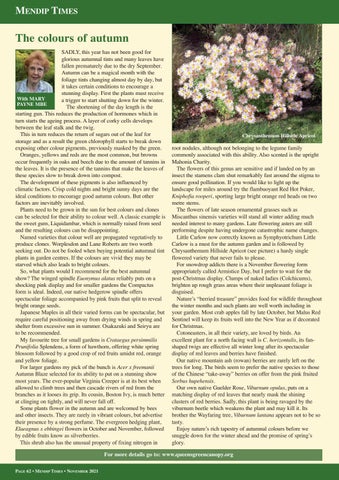Gardening section.qxp_Layout 1 21/10/2021 15:46 Page 62
MENDIP TIMES
The colours of autumn
SADLY, this year has not been good for glorious autumnal tints and many leaves have fallen prematurely due to the dry September. Autumn can be a magical month with the foliage tints changing almost day by day, but it takes certain conditions to encourage a stunning display. First the plants must receive With MARY a trigger to start shutting down for the winter. PAYNE MBE The shortening of the day length is the starting gun. This reduces the production of hormones which in turn starts the ageing process. A layer of corky cells develops between the leaf stalk and the twig. This in turn reduces the return of sugars out of the leaf for storage and as a result the green chlorophyll starts to break down exposing other colour pigments, previously masked by the green. Oranges, yellows and reds are the most common, but browns occur frequently in oaks and beech due to the amount of tannins in the leaves. It is the presence of the tannins that make the leaves of these species slow to break down into compost. The development of these pigments is also influenced by climatic factors. Crisp cold nights and bright sunny days are the ideal conditions to encourage good autumn colours. But other factors are inevitably involved. Plants need to be grown in the sun for best colours and clones can be selected for their ability to colour well. A classic example is the sweet gum, Liquidambar, which is normally raised from seed and the resulting colours can be disappointing. Named varieties that colour well are propagated vegetatively to produce clones. Worplesdon and Lane Roberts are two worth seeking out. Do not be fooled when buying potential autumnal tint plants in garden centres. If the colours are vivid they may be starved which also leads to bright colours. So, what plants would I recommend for the best autumnal show? The winged spindle Euonymus alatus reliably puts on a shocking pink display and for smaller gardens the Compactus form is ideal. Indeed, our native hedgerow spindle offers spectacular foliage accompanied by pink fruits that split to reveal bright orange seeds. Japanese Maples in all their varied forms can be spectacular, but require careful positioning away from drying winds in spring and shelter from excessive sun in summer. Osakazuki and Seiryu are to be recommended. My favourite tree for small gardens is Crataegus persimmilis Prunifolia Splendens, a form of hawthorn, offering white spring blossom followed by a good crop of red fruits amidst red, orange and yellow foliage. For larger gardens my pick of the bunch is Acer x freemanii Autumn Blaze selected for its ability to put on a stunning show most years. The ever-popular Virginia Creeper is at its best when allowed to climb trees and then cascade rivers of red from the branches as it looses its grip. Its cousin, Boston Ivy, is much better at clinging on tightly, and will never fall off. Some plants flower in the autumn and are welcomed by bees and other insects. They are rarely in vibrant colours, but advertise their presence by a strong perfume. The evergreen hedging plant, Elaeagnus x ebbingei flowers in October and November, followed by edible fruits know as silverberries. This shrub also has the unusual property of fixing nitrogen in PAGE 62 • MENDIP TIMES • NOVEMBER 2021
Chrysanthemum Hillside Apricot
root nodules, although not belonging to the legume family commonly associated with this ability. Also scented is the upright Mahonia Charity. The flowers of this genus are sensitive and if landed on by an insect the stamens clam shut remarkably fast around the stigma to ensure good pollination. If you would like to light up the landscape for miles around try the flambuoyant Red Hot Poker, Kniphofia rooperi, sporting large bright orange red heads on two metre stems. The flowers of late season ornamental grasses such as Miscanthus sinensis varieties will stand all winter adding much needed interest to many gardens. Late flowering asters are still performing despite having undergone catastrophic name changes. Little Carlow now correctly known as Symphyotrichum Little Carlow is a must for the autumn garden and is followed by Chrysanthemum Hillside Apricot (see picture) a hardy single flowered variety that never fails to please. For snowdrop addicts there is a November flowering form appropriately called Armistice Day, but I prefer to wait for the post-Christmas display. Clumps of naked ladies (Colchicums), brighten up rough grass areas where their unpleasant foliage is disguised. Nature’s “berried treasure” provides food for wildlife throughout the winter months and such plants are well worth including in your garden. Most crab apples fall by late October, but Malus Red Sentinel will keep its fruits well into the New Year as if decorated for Christmas. Cotoneasters, in all their variety, are loved by birds. An excellent plant for a north facing wall is C. horizontalis, its fanshaped twigs are effective all winter long after its spectacular display of red leaves and berries have finished. Our native mountain ash (rowan) berries are rarely left on the trees for long. The birds seem to prefer the native species to those of the Chinese “take-away” berries on offer from the pink fruited Sorbus hupehensis. Our own native Guelder Rose, Viburnum opulus, puts on a matching display of red leaves that nearly mask the shining clusters of red berries. Sadly, this plant is being ravaged by the viburnum beetle which weakens the plant and may kill it. Its brother the Wayfaring tree, Viburnum lantana appears not to be so tasty. Enjoy nature’s rich tapestry of autumnal colours before we snuggle down for the winter ahead and the promise of spring’s glory.
For more details go to: www.queensgreencanopy.org
